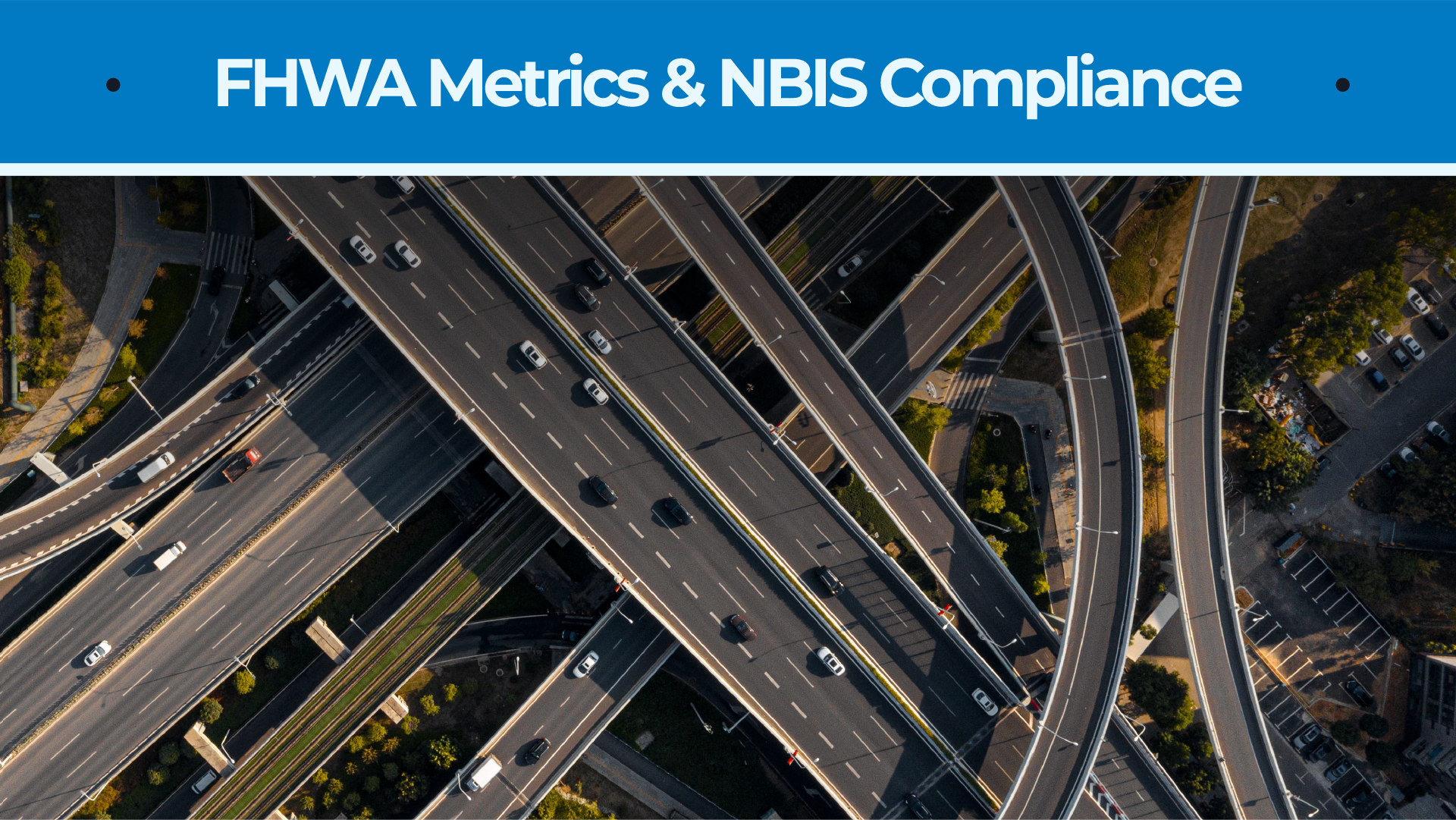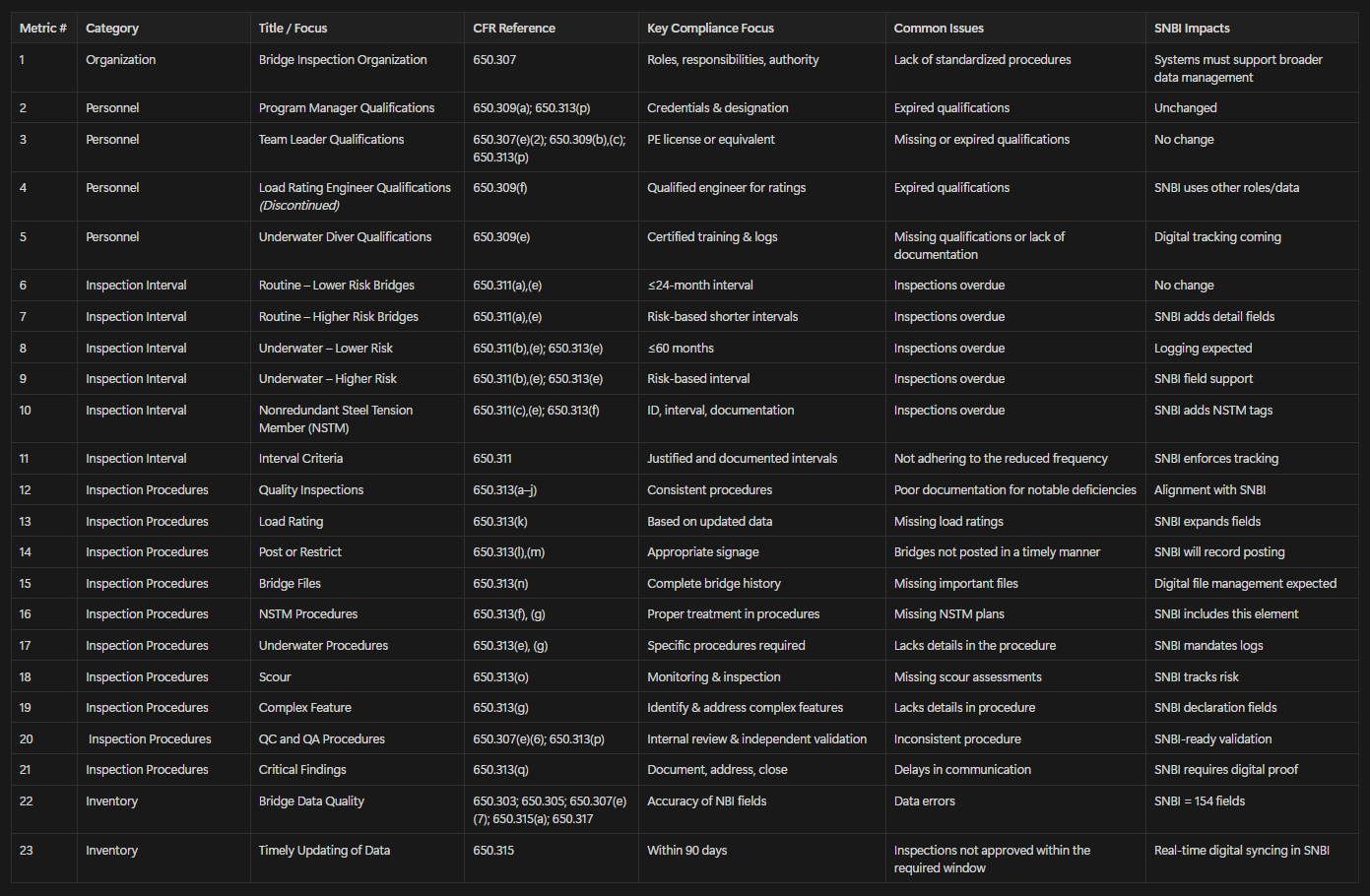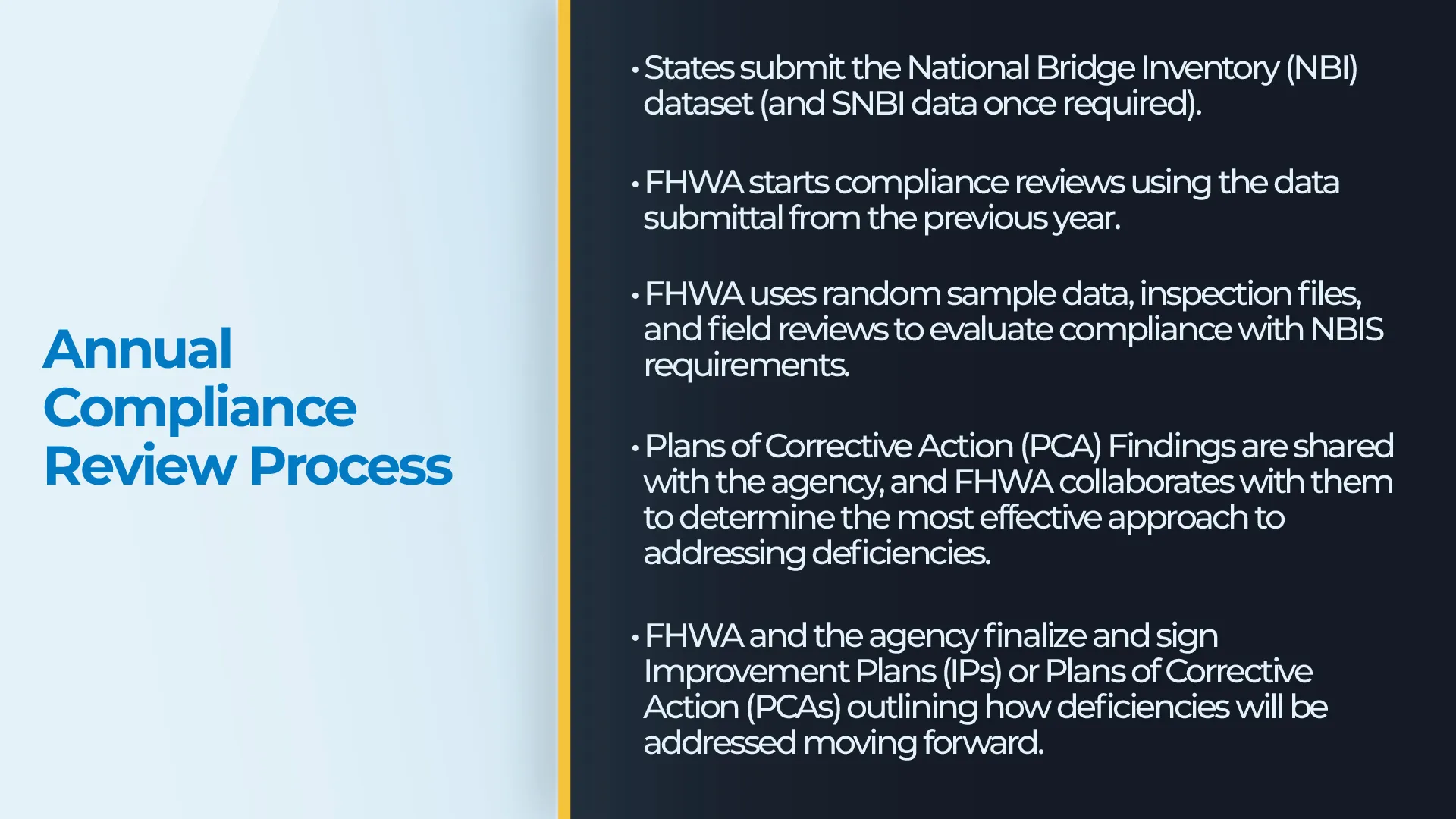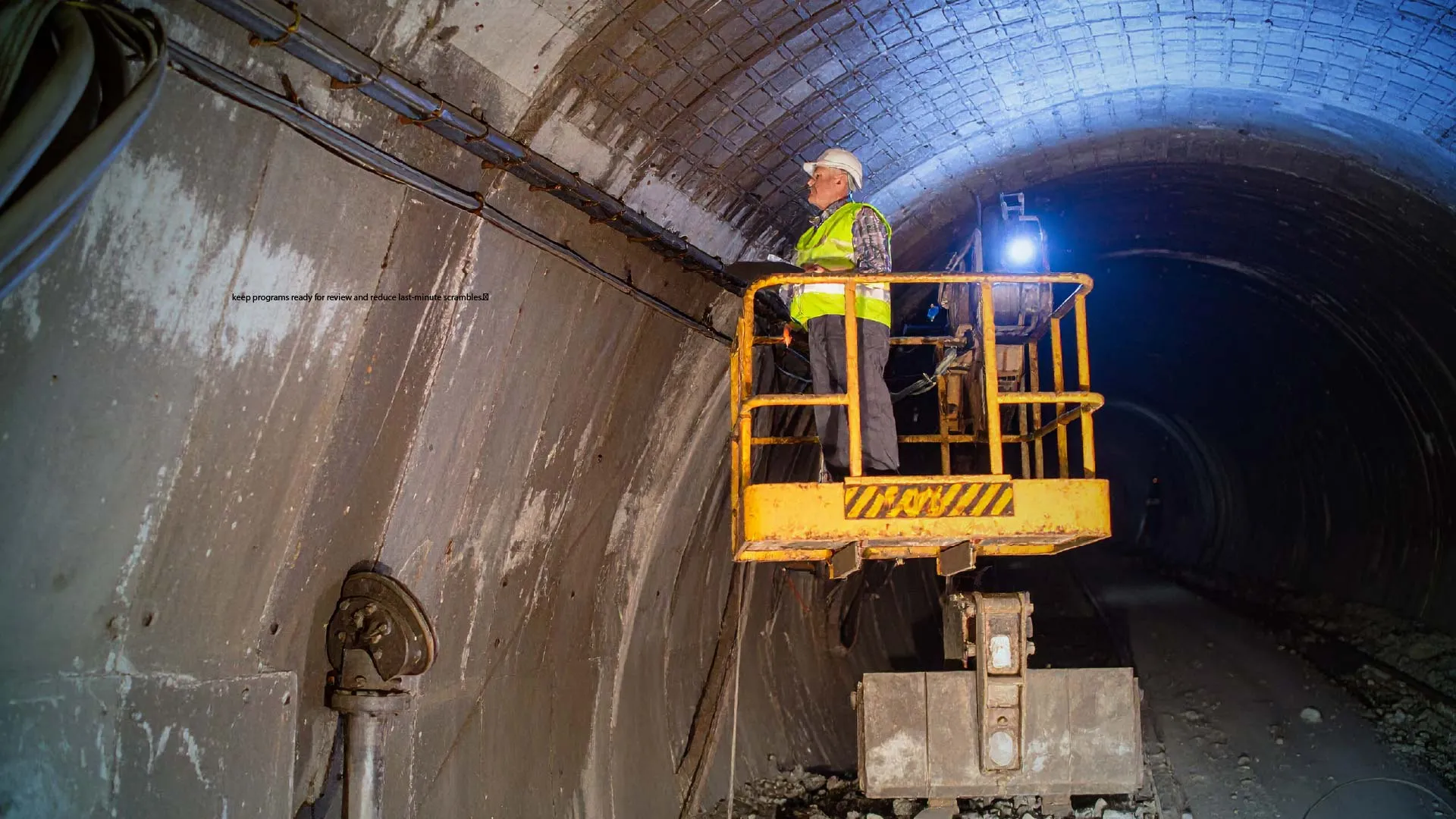
Every highway bridge* in the U.S., from a rural water crossing to a major interstate overpass is inspected under rules set by the Federal Highway Administration (FHWA). To keep those inspections consistent, FHWA uses 23 FHWA Metrics (NBIS) that define how states must plan, carry out, and document their bridge inspections.
*As defined in 23 CFR Part 650 Subpart C.
These metrics outline when inspections must occur, who can perform them, how data is reported, and how issues are resolved, creating one national standard for bridge safety.

FHWA Metrics (NBIS) are a set of 23 performance measures used by the Federal Highway Administration (FHWA) to evaluate state and federal bridge inspection programs. These metrics measure compliance with the National Bridge Inspection Standards (NBIS) and form the basis of FHWA’s annual oversight of every state’s bridge inventory.
FHWA developed these metrics to standardize how bridges are inspected, rated, and documented across the U.S. They provide measurable benchmarks for states, ensuring every bridge inspection program meets minimum federal safety and reporting requirements.
The metrics are the backbone of the NBIP oversight process. They are used to verify that inspections are performed on time, by qualified personnel, with accurate data entered into the National Bridge Inventory (NBI).
These metrics are directly tied to 23 CFR Part 650 Subpart C, the section of federal law that governs bridge inspections. Every metric reflects a regulatory requirement within this code.
FHWA Metrics (NBIS) were created to set clear expectations for bridge inspections and define the standard for bridge owners, and their bridge inspection programs. They serve several key purposes that guide how states manage inspections and stay compliant:
The FHWA framework is built around 23 metrics, grouped into six broad categories: bridge inspection organization, personnel qualifications, inspection frequency, inspection procedures, and inventory data quality. Each metric is reviewed annually and assigned one of four ratings - Compliant, Substantially Compliant, Conditionally Compliant, or Non‑Compliant. Those ratings determine whether a state needs to submit an Improvement Plan for minor issues or a Corrective Action Plan for more serious gaps.
The 23 FHWA Metrics (NBIS) cover every part of the inspection process, from when inspections are scheduled to how critical safety issues are documented and resolved. The table below provides an at-a-glance reference for all 23 FHWA Metrics, followed by expanded explanations of each category.

Metric 1 – Bridge Inspection Organization
Bridge inspection programs must be organized and administered per 23 CFR 650.307, ensuring oversight, resource allocation, and management responsibilities are clearly defined.
Metric 2 – Program Manager Qualifications
Every bridge inspection program must designate a Program Manager who meets the qualifications defined in 650.309(c)(1), including licensure and relevant experience.
Metric 3 – Team Leader Qualifications
Team Leaders must meet NBIS requirements (650.309(c)(2)) to ensure qualified oversight of bridge inspections, including appropriate certifications and field experience.
Metric 4 – Load Rating Engineer Qualifications
This metric has been discontinued and is no longer evaluated under the FHWA Metrics framework.
Metric 5 – Underwater Bridge Inspection Diver Qualifications
Dive team leaders conducting underwater inspections must be certified per 650.309(c)(3) and trained in accordance with accepted diving standards.
Metric 6 – Inspection Interval – Routine – Lower Risk Bridges
Routine inspections are completed within the required interval per 650.313(a), (b), or (c). A bridge must either be inspected at least once every 24 months or approved for an extended interval under specific qualifications.
Metric 7 – Inspection Interval – Routine – Higher Risk Bridges
Inspection frequency is adjusted for bridges classified as higher risk, per 650.311(a),(e). Failure to meet more frequent intervals results in non-compliance.
Metric 8 – Inspection Interval – Underwater – Lower Risk Bridges
Underwater inspections must be completed within the appropriate interval per 650.311(b),(e); typically every 60 months for lower-risk bridges.
Metric 9 – Inspection Interval – Underwater – Higher Risk Bridges
Inspections must follow more frequent intervals when underwater bridge elements are considered higher risk, per 650.311(b),(e); usually no more than 24 months.
Metric 10 – Inspection Interval – Nonredundant Steel Tension Member (NSTM)
NSTM bridges must be inspected with attention to fracture-critical characteristics and appropriate intervals, per 650.311(c),(e); 650.313(f).
Metric 11 – Inspection Interval – Interval Criteria
Bridge-specific criteria for determining inspection intervals must be well documented, justified, and applied consistently per 650.311.
Metric 12 – Quality Inspections
Inspections must adhere to a quality process across planning, execution, and documentation, as required in 650.313(a) to (j).
Metric 13 – Load Rating
Each bridge must have a documented load rating, considering current structural conditions and following methods in the AASHTO Manual for Bridge Evaluation, per 650.313(k).
Metric 14 – Post or Restrict
If load ratings indicate insufficient capacity, the structure must be posted or restricted accordingly, per 650.313(l),(m).
Metric 15 – Bridge Files
Bridge files must contain required information (plans, inspections, load ratings) and be organized for accessibility per 650.313(n).
Metric 16 – Nonredundant Steel Tension Member Inspection Procedures
Inspection procedures specific to NSTMs must be in place and followed per 650.313(f), (g).
Metric 17 – Underwater Inspection Procedures
Procedures for conducting underwater inspections must be developed, documented, and consistently applied per 650.313(e), (g).
Metric 18 – Scour Inspection Procedures
Scour inspections must be conducted using appropriate methodology and protocols as defined in 650.313(o).
Metric 19 – Complex Feature Inspection Procedures
Inspection procedures for complex structures (movable bridges, tunnels, etc.) must meet the standards in 650.313(g).
Metric 20 – QA/QC (Quality Control & Quality Assurance)
States must have documented Quality Control (QC) and Quality Assurance (QA) programs to ensure accuracy, consistency, and oversight of inspections and data, per 650.307(e)(6); 650.313(p).
Metric 21 – Critical Findings
All critical findings must be acted on promptly. States must document and verify that temporary or permanent corrective actions have been taken, per 650.313(q).
Metric 22 – Bridge Data Quality
States must ensure their bridge data (inventory and inspection data) are complete, accurate, and consistent with field observations and bridge files, per 650.305; 650.307(e)(7); 650.315(a); 650.317.
Metric 23 – Timely Updating of Data
Updates to the bridge inventory and inspection data must be made within 90 days of identifying changes or completing inspections, per 650.315.
1: Program Oversight
This metric verifies that an organizational structure is in place to ensure all public highway bridges are inspected in accordance with NBIS requirements, with clearly defined roles, responsibilities, and delegated functions, and a designated Program Manager responsible for compliance.
2–5: Personnel Qualifications
These metrics ensure that every bridge inspection program is led by qualified professionals and organized for success. From Program Managers and Team Leaders to certified underwater divers, FHWA reviews both qualifications and documentation.
6–11: Inspection Intervals
These metrics cover the timing and frequency of bridge inspections — whether routine, underwater, or focused on specific risks like nonredundant steel tension members. Agencies must justify extended intervals and tailor frequencies based on bridge risk profiles.
12–21: Inspection Procedures
These metrics look at how inspections are actually performed — from quality controls to procedures for complex, underwater, scour-prone, NSTM, or critical structures. Documentation, consistency, and alignment with federal regulations are essential for compliance. States are required to implement both quality control (to verify inspection accuracy) and quality assurance (to ensure the effectiveness of the QC program). These elements are jointly assessed under Metric 20 and are critical to maintaining the credibility of the overall inspection program.
22–23: Inventory Data Management
These metrics focus on the preparation, maintenance, and submission of bridge inventory data in alignment with FHWA requirements. All bridges subject to the NBIS must have accurate inventory data recorded according to federal procedures. Additionally, this data must be reviewed and approved within 90 days after inspection completion.
Each year, FHWA uses the 23 Metrics to review how well every state and federal bridge program is meeting national inspection standards.
Each year follows a predictable review rhythm. Knowing these deadlines helps states stay ahead of FHWA findings and prepare for the SNBI transition.

Annual Review Cycle
With deadlines and reviews coming every year, states benefit from a simple checklist to stay prepared and avoid surprises during FHWA evaluations.

Before Each FHWA Review:
For SNBI Readiness:
While this document focuses on the 23 metrics of the National Bridge Inspection Standards (NBIS), FHWA applies a similar oversight framework to tunnels. Under the National Tunnel Inspection Standards (NTIS), FHWA evaluates tunnel programs using a dedicated set of 15 compliance metrics, introduced in 2019, to address the unique safety and operational needs of tunnel infrastructure. These metrics are reviewed annually using a risk-based process, paralleling the NBIS approach. For detailed information, see this National Tunnel Inspection Standards (NTIS)

Managing thousands of bridge and tunnel inspections, certifications, and reports each year requires more than just spreadsheets. Agencies are turning to platforms like inspectX™, which streamline inspection workflows, track inspector credentials, generate automated reminders, and produce FHWA‑ready reports.
With the upcoming SNBI transition, inspectX™ is fully equipped to support the new SNB JSON formats and expanded data fields required by FHWA.
Unlike many other platforms, inspectX™ features a dedicated Metric Module that enables agencies to manage and monitor compliance with all 23 FHWA Metrics - centralizing bridge inventory and inspection program oversight in one unified system.
FHWA’s latest reviews show recurring pressure points that states are struggling with - from stricter oversight of critical findings to ongoing staffing gaps and the slow shift from paper files to fully digital systems. The most common challenges include:
The final rule for the revised National Bridge Inspection Standards (NBIS) was published on May 6, 2022, and became effective on June 6, 2022. The rule implements requirements from MAP-21, including extending NBIS to Tribally owned bridges, updating personnel qualifications and inspection intervals, establishing a national inspector registry, aligning with tunnel inspection standards, and enhancing procedures for critical findings and element-level data collection.
The Specifications for the National Bridge Inventory (SNBI), 2022, were incorporated by reference in the final rule and replace the 1995 FHWA Recording and Coding Guide. The first SNBI-based bridge inventory submittal to FHWA’s NBI is due in March 2026.
Some NBIS changes took effect in 2022 and are assessed starting with Performance Year 2024 (PY24). Others, including new metrics for personnel qualifications, special inspection intervals, and in-depth inspection procedures, will not be assessed until PY25. SNBI data requirements will be implemented over several years, with full compliance expected in later review cycles.
Notable metric updates include:
Non-compliance with FHWA Metrics (NBIS) has real consequences; it can stall funding, draw federal intervention, and leave public safety at risk. The key risks agencies face include:
FHWA has even required Plans of Corrective Action when unsafe bridges weren’t addressed promptly.
States that meet FHWA standards consistently focus on a few essentials:
These practices keep programs ready for review and reduce last‑minute scrambles.

The FHWA Metrics (NBIS), and soon SNBI, set the standard for how America’s bridges and tunnels are inspected, documented, and safeguarded. Staying compliant isn’t just about passing an annual review; it’s about protecting public safety, maintaining federal funding, and ensuring that every structure meets the same reliable standard. By following best practices now and preparing for upcoming changes, agencies can stay ahead of requirements and focus on what matters most: keeping the nation’s infrastructure safe and trusted for years to come.
Ready to strengthen your compliance efforts? Schedule a Call with us to see how the right software platforms can simplify reporting, streamline inspections, and keep your program FHWA-ready year-round.
Download the free FHWA 23 Metrics Explainer PDF - a concise one‑pager summarizing all metrics, categories, and compliance essentials.